Namibia / Republic of Namibia – Let’s explore here
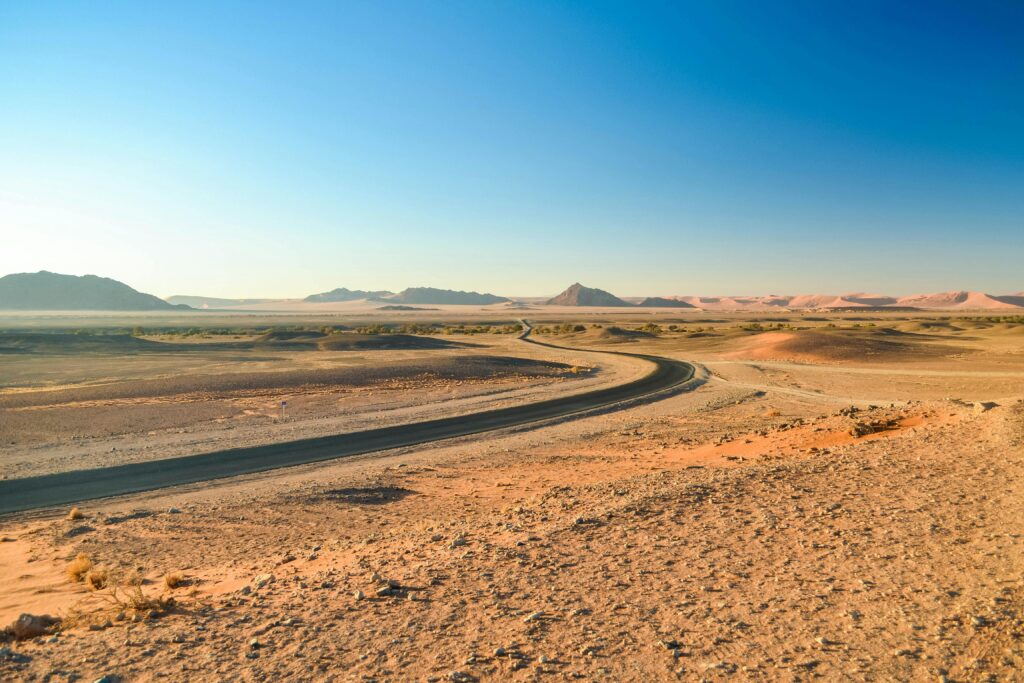
What’s it like in Namibia?
Namibia is a large and beautiful desert country in southern Africa. It’s about 3½ times the size of the UK, and mainly consists of a central plateau that runs north-south, surrounded by the Namib desert in the west and the Kalahari Desert in the east. The Namib lays claim to being the oldest and driest desert in the world, and has the highest dunes anywhere. The highest point in the country is Brandberg Mountain, in the north west, at 8,442 ft (2,573 m) above sea level.
It has a very long, rich and troubled history, finally gaining independence in 1990. It shares land borders with Angola, Botswana, South Africa and Zambia, and it’s also just over 600 feet (183 m) away from Zimbabwe!
The population of Namibia is around 3 million people (2023), about ½ million of who live in the metropolitan area of the capital, Windhoek. It’s one of the least densely populated countries in the world. It relies heavily on tourism and mining.
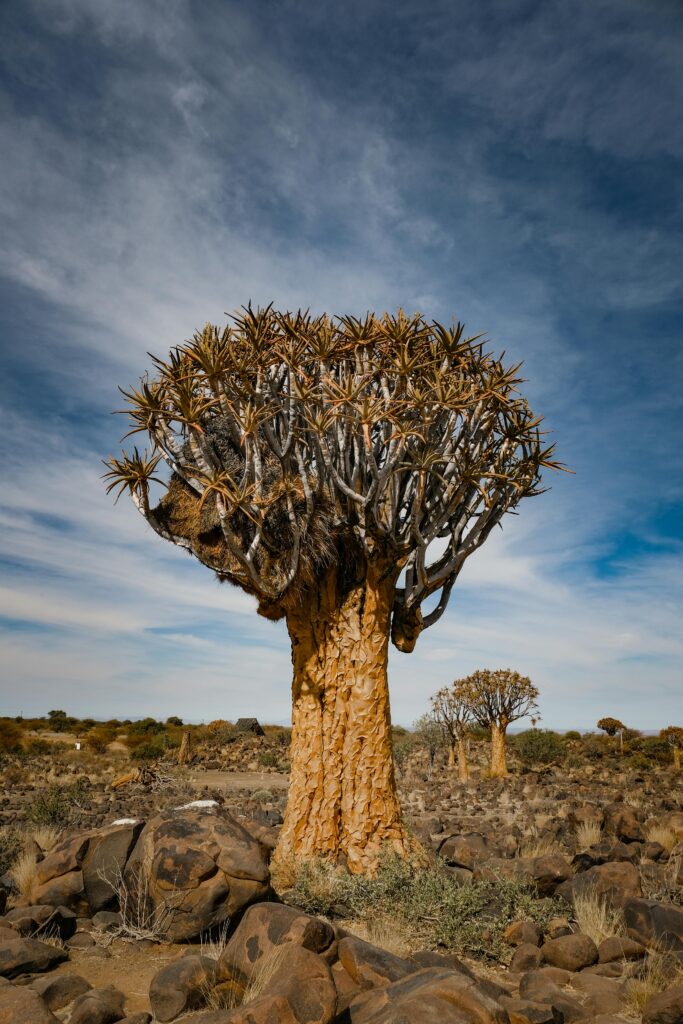
A bit about the history of Namibia
Early History and Indigenous Peoples
Namibia has a rich history shaped by its diverse indigenous peoples, including the San (Bushmen), Nama, Herero and Damara, who lived in the region for thousands of years. The San were among the earliest inhabitants, known for their hunter gatherer lifestyle, while the Nama and Herero developed cattle herding cultures. The region’s coastal area also saw the development of trade networks, particularly with the early Portuguese explorers in the 15th century.
European Exploration and Colonisation
In the late 19th century, European powers began to show interest in Namibia. The first European to make significant contact were the Portuguese in the 15th century, but it was not until the late 1800s that the German Empire began to establish a more permanent presence. Germany formally colonised the region in 1884, calling it German South West Africa. The German colonial administration was marked by the exploitation of the indigenous peoples, especially through land appropriation and forced labour. The indigenous groups, particularly the Herero and Nama, resisted German rule, leading to the Herero and Namaqua genocide from 1904 to 1908. The German military’s brutal response resulted in the deaths of approximately 80,000 Herero and 10,000 Nama people, making it one of the first major genocides of the 20th century.
South African Mandate
After Germany’s defeat in World War I, the League of Nations mandated the territory to South Africa in 1915, who essentially treated the territory as a colony, enforcing discriminatory policies similar to those it had established in South Africa. This included the imposition of apartheid laws, which segregated and discriminated against the indigenous African population. During this period, various Namibian groups began to resist South African rule. One of the most prominent movements was the South West Africa People’s Organisation (SWAPO), founded in 1960. SWAPO, initially a non-violent organisation, gradually shifted towards armed resistance in the 1960s, after South Africa refused to grant the region independence.
The Liberation Struggle and the Road to Independence
Throughout the 1960s and 1970s, SWAPO waged an armed struggle against South African rule with support from the Soviet Union, Cuba and other socialist countries. The struggle was marked by significant hardship, including South Africa’s military presence and the use of ‘bantustans’, or designated homelands, to try and segregate the population. The United Nations recognised SWAPO as the legitimate representative of the Namibian people in 1966, and by the 1970s, the conflict had become an important issue in global discussions about decolonisation. Namibia’s struggle for independence was also part of the broader fight against apartheid in southern Africa.
In 1978, after years of resistance, South Africa agreed to hold UN-supervised elections as part of a peace process, leading to the signing of the 1988 New York Accord, which stipulated that South Africa would grant Namibia independence. In exchange, Cuba agreed to withdraw its troops from Angola, and Namibia would eventually become independent with free elections.
Independence and Nation-Building
Namibia officially gained independence from South Africa on 21 March 1990, following a historic peace process. SWAPO, led by Sam Nujoma, won the first democratic elections and formed the new government, with Nujoma becoming the country’s first president. The new constitution, which guarantees civil liberties and human rights, came into effect alongside independence, marking a fresh start for the country.
In the early years of independence, Namibia faced significant challenges, including high unemployment, poverty and the need to rebuild after years of conflict. However, the country made steady progress in areas such as education, infrastructure and health care. Namibia also took steps to address its past injustices, including land reform and efforts to promote national reconciliation. Despite this progress, Namibia’s economy was still heavily dependent on mining, particularly diamonds and uranium, and the country struggled with a large informal sector, inadequate infrastructure in rural areas and a high level of inequality.
Sam Nujoma’s Presidency
Sam Nujoma was re-elected as president in 1994 and again in 1999, and his leadership was instrumental in the early years of independence. Nujoma’s administration was focused on nation building, economic development and international diplomacy, seeking to position Namibia as a stable and independent player in southern Africa. Under his leadership, Namibia did maintain a relatively stable political environment, although critics argued that the government was slow to implement necessary economic reforms, particularly in addressing issues like poverty and unemployment. Nujoma also focused on maintaining close ties with other African nations, particularly in the context of the African Union and southern African regional organisations.
Hifikepunye Pohamba and Continued Economic Growth
In 2005, Sam Nujoma stepped down after his two-term limit, and Hifikepunye Pohamba, a fellow SWAPO member, was elected president. Pohamba’s presidency (2005–2015) continued many of the policies set out by Nujoma, including economic development and national reconciliation, while also focusing on tackling corruption and improving social services.
Namibia’s economy continued to grow, driven by its mining sector, especially diamonds and uranium, as well as agriculture and tourism. However, the country still faced significant economic inequality, with high levels of poverty and unemployment, particularly in rural areas. Pohamba’s tenure was marked by a stable, peaceful political environment, and he was credited with overseeing the peaceful transfer of power when his successor, Hage Geingob, took office.
Hage Geingob’s Presidency
Hage Geingob, a veteran SWAPO member and former prime minister, became Namibia’s third president in 2015. His presidency has been focused on tackling corruption, improving economic diversification, and addressing socio-economic challenges such as poverty and inequality. Geingob introduced policies aimed at boosting the country’s industrialisation, including the ‘Harambee Prosperity Plan’, which sought to create jobs, attract investment and improve public services.
Despite these efforts, Namibia’s economy faced several challenges during Geingob’s tenure. The country’s reliance on mining, particularly in uranium and diamonds, meant it was vulnerable to global market fluctuations. The agricultural sector also struggled due to climate change and drought conditions, leading to food insecurity. Geingob’s administration has also faced criticism for not making more progress on land reform, a highly sensitive issue in Namibia due to the historical dispossession of land from indigenous peoples during colonial rule. There has been growing pressure for the government to implement more radical land redistribution measures to address the imbalances of the past.
Key Challenges and Developments in the 2020s
As of 2025, Namibia continues to face a range of challenges. Although it remains one of Africa’s most stable democracies, there is still a significant gap between the rich and poor, and many Namibians face unemployment and lack of access to basic services. The COVID-19 pandemic, like in many countries, worsened the economic situation and exacerbated social inequality. On the international front, Namibia continues to maintain its position as a peaceful and cooperative actor within southern Africa. The country is also an important player in the fight against climate change, as it faces rising temperatures and droughts that impact agriculture and water resources.

Namibia road trip
Our Namibian road trip is part of a much larger African road trip.
Map of our road trip through Namibia
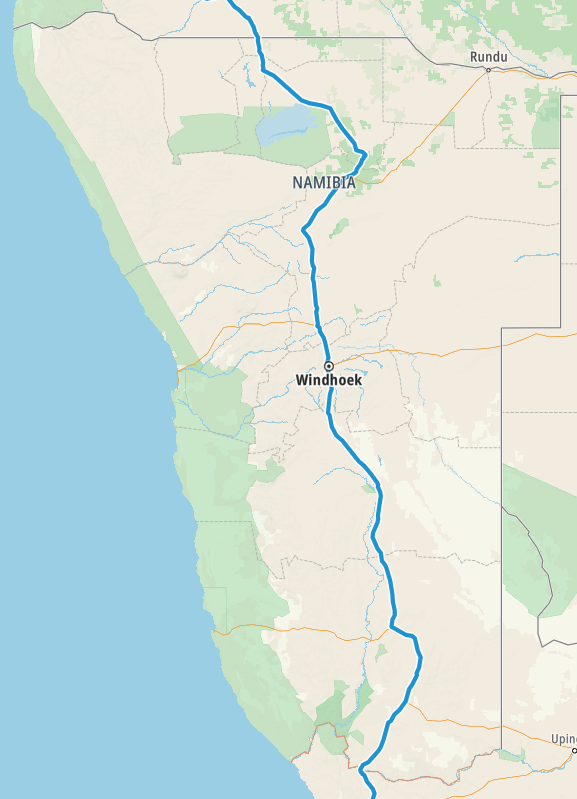
Our current planned Namibian road trip takes us from Angola towards the capital, Windhoek, before moving on to South Africa.
No doubt we’ll explore the country much more than this continent-spanning short route shows, in particular checking out the coast and inland Namibia.
Hopefully our journey will improve our knowledge of this intriguing and beautiful country, and enable us to meet some interesting people. We’ll be updating this page at that time – don’t forget to check back 🙂
What’s it like to drive in Namibia?
They drive on the right hand side of the road in Namibia. In the main, roads are very poor, with many being unsurfaced dirt tracks. Driving standards are also poor.
Do you require an international driving permit in Namibia?
We’ve created a dedicated page to driving abroad, which answers this question, and more, which you might find helpful.
Can you use your UK driving license when driving through Namibia?
We’ve created a dedicated page to driving abroad, which answers this question, and more, which you might find helpful.
Do I need a carnet de passages to drive in Namibia?
A Carnet de Passages is required to overland in Namibia. We’ve created a dedicated page to driving abroad, which answers this question, and more, which you might find helpful.
What currency do they use in Namibia?
In Namibia they use the Namibian Dollar, although the South African Rand is also accepted. Cash is widely used. The use of credit / debit cards is not widely accepted outside of the capital, Windhoek. Travellers cheques are not readily accepted. There are some ATMs in cities throughout the country.
You should make yourself aware of the amount that your bank charges you for using credit and debit cards abroad. Often credit cards are cheaper for purchasing items directly, and for withdrawing cash from ATMs.
What language do they speak in Namibia?
They mainly speak English, Afrikaans, Oshiwambo and German in Namibia.
What time zone is Namibia in?
Remember, when you’re planning your next trip to take a look at what time zone it’s in.
Do I need a visa to visit Namibia?
We’ve created a dedicated, more comprehensive page on visas, which you should find helpful. Check it out!
Is wild camping legal in Namibia?
Yes, wild camping is fine in Namibia.
What plug / socket type do they use in Namibia?
In Namibia they use plug / socket types D and M.
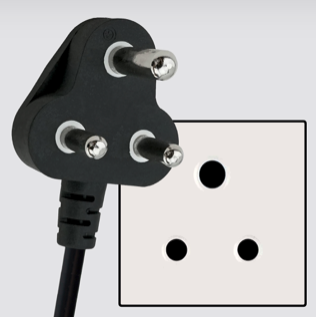
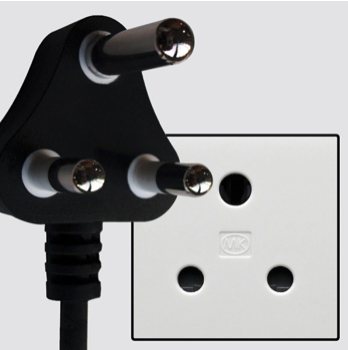
Health issues in Namibia
Is it safe to drink water in Namibia?
No, it is not safe to drink tap water in Namibia. Bottled water is readily available throughout the country.
What vaccinations are required for Namibia?
This NHS website is kept up to date with all relevant information on vaccinations in Namibia.
Phones in Namibia
What is the country calling code for Namibia?
The country calling code for Namibia is +264
What are the emergency phone numbers in Namibia?
- The emergency number for police in Namibia is: 10 111
- In Namibia, the emergency number for ambulance is: different for every area! Try 999
- The emergency number for fire in Namibia is: different for every area! Try 999
If you’ve got some useful info that you’d like to share, let us know!
And don’t forget to check out all the other pictures!
